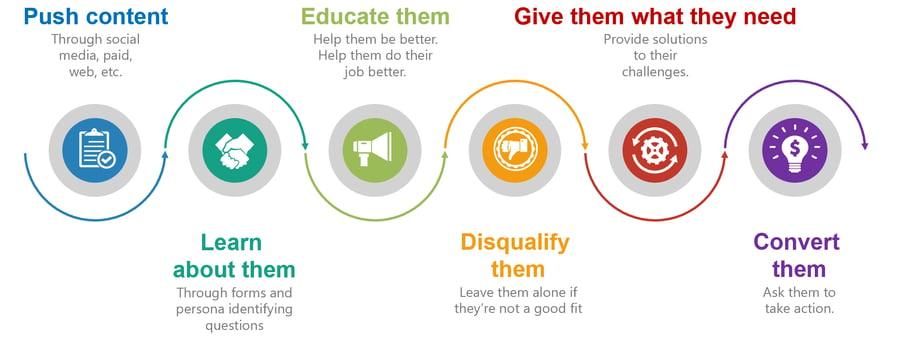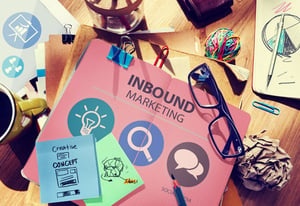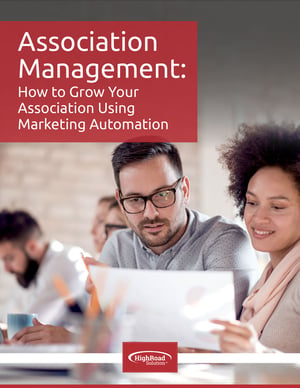
Association Management: How to Grow Your Association Using Marketing Automation

The concept of marketing automation may seem nebulous and untouchable for those of us who haven’t had experience with it. Terms like C4C (content for contact), lead scoring, and workflow management may seem far outside of the confines of our comfortably traditional marketing approaches.
Yet, when we really break down the core of marketing automation, we see that it’s not far off what we—as marketers, technologists, and beyond—have been doing all along. The difference—marketing automation means we’re now integrated, as are the tools we use every day. Our channels and platforms aren’t just talking with one another. In some cases, they’re sharing the same brain.
From a functional perspective, a marketing automation platform—not to be misconstrued with an email platform—bundles together multiple
If that’s still a little bit too ambiguous, here’s a good visual to help illustrate what can be a very obscure idea for those associations on the perimeter of adoption.

There’s no questioning there’s been a fundamental shift for associations over the past decade. Much like our for-profit counterparts, we’ve gone through—and are stilling going through—the digital shift albeit a few years later. On the digital maturity model, moving from an association centric to user centric tier is just the first step when it comes to digital evolution. Associations are in now in the age of digital transformation.
So let’s review how we’ve gotten here…
In the past, marketing departments (if they even existed) within organizations were siloed and codependent. IT departments held the keys to software purchases, training, and budgets, and only a handful of highly ‘technical’ (and not necessarily business- or marketing-minded) super users had access to the tools that collected, ran, and stored data. Cut to—another once obscure turned mainstream concept known as social media.
The introduction of social media outlets induced inclusivity and unsheltered access to people and data, unleashing an entirely new cultural marketing evolution. Marketers soon realized control over outbound communications wasn’t enough. They needed to take the inbound wheel. They needed to start with the data and follow with the message.
Suddenly, skill sets started to evolve. Marketers upped their tech proficiencies and took the helm on data coming through the door. They started phasing away from communication frequency and volume and focusing on metrics, nuances, and buying behaviors. They became the purveyor of the data and their platforms. Engaging, nurturing, and ultimately procuring revenue started evolving their roles as marketers. They no longer needed to be association experts. They needed to be customer experts at the most individualized levels.
As skill sets evolved, organizations started evolving in parallel. Communication and editorial departments were supplemented with ‘for-profit’ modeled marketing arms. Marketing and IT departments reorganized for better collaboration. Technology stacks went beyond the big three (association management system, event management system, and content management system) and started connecting their systems with enterprise marketing systems and marketing automation platforms. Intimate, integrated, intelligent marketing was underway.
Now that we’re in the age of digital transformation, it’s no longer about larger associations with deeper pockets evolving to
So, we know it’s happening all around us. We know that to sustain ourselves as organizations, we need to at least consider the concept. But what are the guiding factors to help us know when (and if) to pull the trigger? There are two very simple, very common factors to consider when determining the need for a marketing automation platform. As an organization, you want to:
Gain insight
Grow revenue
Now, improving operational efficiency may be a “nice-have, nice-fix” scenario once an organization starts adopting marketing automation, but it’s not enough of a reason to justify the move. While your staff hours, time, and grievances may be reduced with automated sequences, you’re still not in the sphere of true marketing automation until you’re gaining insight and/or growing revenue. Improving operational efficiencies can certainly reduce your bottom line but there has to be a revenue growth tie in order to check off the box.
 Every strategic plan, every marketing plan, every campaign starts with an objective. If one of your objectives is to get more intel on your constituents, that in itself warrants investment in a marketing automation platform. Organizations need to start thinking beyond email opens and clicks. Those metrics are only measuring the effectiveness of that particular communication on the most surface level at that. Those metrics don’t get organizations into the minds of their potential buyers or members.
Every strategic plan, every marketing plan, every campaign starts with an objective. If one of your objectives is to get more intel on your constituents, that in itself warrants investment in a marketing automation platform. Organizations need to start thinking beyond email opens and clicks. Those metrics are only measuring the effectiveness of that particular communication on the most surface level at that. Those metrics don’t get organizations into the minds of their potential buyers or members.
As a marketer, it’s in your best interest—and your organization’s best interest to go beyond simple email tracking. Getting to know your members and/or prospects will better position you to service them. You want to go beyond standard audience segmentation demographics. You want to dive deep into their challenges, nuances, engagement levels, learning preferences, just to name a few.
Imagine if you were able to sit down with every one of your members and prospects for a one-hour coffee chat once a week. That’s the level of familiarity you want—and can get—through marketing automation. Whether you use the information for your programmatic content strategy or your lead generation plan, you need to get up close and personal with your audiences. Particularly if your membership demographics are shifting, you’re seeing declines in retention, or your organization doesn’t seem to be growing organically as it has in the past.
 In less than a decade, the global economy is going to see a fundamental shift as the baby boomers exit stage left into retirement. As most businesses in the world are preparing for these cultural workforce shifts, associations are preparing in a different way.
In less than a decade, the global economy is going to see a fundamental shift as the baby boomers exit stage left into retirement. As most businesses in the world are preparing for these cultural workforce shifts, associations are preparing in a different way.
Most associations who historically basked in the glory of organic growth and the “if you build it, they will come” mentality, are now reeling from the reality that they need sustainable growth strategies. Whether the dollars are going into diversifying revenue, program development, or member acquisition, associations are shifting mindsets for self-preservation.
Outbound prospecting alone is no longer a viable option. Database decay is a real thing—about 20% of email marketing databases or lists go bad in x of time. Buying lists
You go inbound.
Marketers need inbound strategies to identify the buyers in line with their offerings and nurture them into conversion. Inbound methodology, the most critical part of marketing automation, is about generating leads through content and engaging your prospective buyers until they’re ready (on their timeline) to make a purchase decision. It’s the new digital formula. You make the connection. You relate to them. You educate them. And if they identify themselves as a good fit based on the content you’re putting out there, you invite them to take action. Not only do you have optics into their journey,
This is key for the newer “end of the alphabet” generations who don’t want to be handed droves of information on irrelevant programs and services. They’re instant gratification seekers who are fast moving and deliberate in everything they do. They want you to take the time to get to know them and provide them with offerings that fit their profile. In turn, they want to get to know you on their time. If the time is right, the content is right, and the program is right, you’re on your way to
|
It doesn’t stop at the association marketing plan. It impacts all departments and business areas. It’s not just about investing in the platform. It’s about infusing it within your organization and using it to its full capacity. You’re getting the most out of a marketing automation platform if you’re able to accomplish the following. |
|
Identify buying patterns for building an association marketing plan Once your buyer is in your automation funnel, whether as a member or a prospect, you’ll start to learn more about their lifecycle, including:
|
|
Right-side and rejuvenate your programs and services Sometimes you need to look at your overall product sets. In the case of associations, product sets are the programs they offer and the intellectual capital from the community (i.e. conferences, webinars, advocacy programs, career services, etc.). Automation can help you:
|
|
Get optics into tomorrow How do you plan for the future if you don’t have sight into what’s to come? What does your 5-year strategic plan look like? Marketing automation can help you:
|
|
Appeal to today’s—and tomorrow’s—shopper The ultimate impetus of marketing automation is that entire shopping experience has changed and associations need to adjust for that. They need to:
|
Putting everything known about marketing automation into practice is the next chapter for associations. There’s not a one size fits all software that addresses associations’ needs to both attract and retain members. In fact, we often recommend to our clients that these two goals are separated and nurtured through different tools.
In some cases, our clients are attaining these goals by combining different software solutions like marketing automation platforms, email service providers, or other specialized products like our Intelligent Contextual Email (ICE). When taking a step back, the birds-eye view of the digital formula is a collection of software solutions that play together to continuously produce results at every stage of the member and prospective member journey.
So how exactly do these tools all work together?
Examples: SharpSpring, HubSpot, Marketo, Act-on
Marketing automation software is a lead generating and lead nurturing engine. The automation functionality allows organizations to create compelling landing pages with forms that capture leads; promising an industry eBook, webinar, or content-rich “hook” that draws the potential member into what the association has to offer.
Lead nurture workflows then funnel the lead through a nurture sequence with multiple touch points. Every interaction adds iterative value leading up to the hard ask at the end of the funnel.
Through marketing automation, organizations are leveraging the inbound methodology to organically drive leads at the top of the funnel to ultimate conversion, whether signing up for membership, registering for an event, and/or purchasing a product. Throughout the process, organizations are collecting more data points that tell us more about their buyers as they progress through the funnel.
Examples: Adestra, Blue Hornet, Constant Contact
Email service providers are
In some cases, organizations are leveraging these email service providers to filter and clean lists before transferring contacts into marketing automation platforms with justifiably rigid list purchase policies. In these instances, email platforms are used to drive prospects to
The key takeaway is that email service providers are typically used for large volume email sends (with already qualified and invested audiences) and marketing automation software is better leveraged for focused, personalized, nurture and drip campaigns (with prospective and net new audiences).
To augment member retention efforts, and to tap into the growing need for more intimate communication, associations are seeking out hyper-personalization tools for their member communications.
Many 0f our clients are powering their member newsletters with tools such as our Intelligent Contextual Email (ICE). Our clients are finding that layering this tool with their platforms
Members are no longer getting blanket updates with often irrelevant information. They’re getting deliberate and personal messages that are completely unique to them, their chosen preferences, and their profiles. That’s individualized, intelligent, intimate communication at its finest.
Consumers get this experience all the time. Take car insurance companies like Geico. Geico will send you a personalized reminder when your insurance payment is due along with past interactions connected to your account. That’s a high-value, meaningful touch point.
Imagine if organizations could include member dues renewal dates, CPE credit totals, and personally chosen article topics based on their members’ chosen preferences? Incorporating this caliber of customization lets them interact one-on-one with all of their constituents with zero manual work.
Automation isn’t automation unless it pivots off of well-defined personas. Persona development isn’t necessarily interchangeable with audience segmentation because audience segmentation tends to yield basic demographic information.
Persona development uncovers more information about the buyer’s nuances, challenges, soft attributes, and opportunity areas, just to name a few.
For associations, a buyer persona can go a step further to shape programmatic content as part of an organization’s overall content strategy. In other words, knowing your buyer can be a key ingredient to help shape your actual program offerings, whether conference tracks, webinar series, mentor programs, etc.
Once organizations have the collective software “engine” to generate leads and retain members, they still need to provide valuable content to fuel the engine. Whether curated content, event news, and other relevant assets like eBooks, industry reports, and webinars, association content creators are more equipped than any other industry to execute
From the moment a prospective member reads an email, fills out a form, or visits a website, they’ll go down a personalized nurture experience; also called the buyer’s journey. And it doesn’t end at conversion. Once a prospect becomes a member, the content they receive is vetted and hand-picked, propagating their perceived member value.
The power of marketing automation lies in the data. Marketing automation allows visibility into every digital touch point in the buyer’s journey; where historically, insight was either vague or at an aggregate level. Through marketing automation, organizations are now tracking touchpoints via social, email, websites, forms, content downloads, and program engagements. By arming associations with greater knowledge into their prospects’ behaviors, associations are better equipped to service the needs and interests of their users.
With a data-driven feedback loop into content asset performance, association marketing teams can better inform and optimize their campaigns in the future. By generating and repurposing quality, compelling content, associations can fuel the entire experience without any physical interaction. The digital evolution puts the experience into the buyer’s hands. In fact, 70% of the purchasing decision has already been made by the user before a conversation has even taken place.
This content methodology can be likened to that of the Choose Your Own Adventure children’s books published in the 80s and 90s. Much like these books where the outcomes of the story
Associations are primed to give everything away as part of their overall value of membership. Shifting into a consumer product marketing mindset means demanding an email address for nearly everything put out there. The associations that shift to these ‘give-and-take’ mindsets from the one-sided exchanges are better equipped for growth. The question then becomes how do organizations continue to provide their members with value while focusing on non-member acquisition efforts within minimal overlap? The answer, although not simple, is definitely possible—create a programmatic content strategy in addition to your content marketing strategy that bilaterally addresses both audiences.
With marketing automation—and inbound marketing—organizations are focusing not only on
Quantifying efforts in marketing automation goes one step further with lead scoring. This standard platform feature assigns points based on the deemed importance of each piece of content, engagement level, and touch point within the overall equation. Through this designation, marketers are able to build a hierarchy with their buyers and interact with them according to their score. Through lead scoring, marketers are also able to identify unqualified customers so that they’re not putting effort into unaligned audiences.
Nurturing leads, retaining members, and delighting buyers aren’t new concepts. Organizations have been practicing versions of these principles for years. The difference lies in synchronization. Through automation, associations’ efforts are captured in single automated, data-driven workflows. Otherwise known as buyer journey, this harmonized means of engaging at the most individualized levels continues as the primary differentiator in modernized digital marketing techniques.
Of course, before you can do anything, you need stakeholder buy-in. It’s not enough that your marketing department, or even your IT department, is on board with automation. Your entire organization has to see value in the methodology. If you’re interested in building a business case with your leadership, volunteers, and staff, get in touch with us and we’ll set-up a buy-in consultation.
How the WIA marketing team—of none—became a strategic marketing powerhouse
 Founded in 1974, The Wallcovering Installers Association (WIA) is the only trade association dedicated exclusively to the interests and needs of wallcovering installers and those involved in the craft.
Founded in 1974, The Wallcovering Installers Association (WIA) is the only trade association dedicated exclusively to the interests and needs of wallcovering installers and those involved in the craft.
It’s also important to note that, from a WIA staffing perspective, there was professional marketer on staff. Although they had great support from volunteers and administration, they lacked the expertise, and frankly, dedicated resources to effectively market to the WIA community and beyond.
In the past, WIA didn’t have a strong need for a membership growth plan. The rise of wallpaper in the 1970s and beyond steadily--and organically--grew their membership base with loyal and successful wallcovering installers. However, realizing that the majority of their current members were between the ages of 48 and 58 and planning their retirement, they forecasted a 63% membership decline happening in less than a decade. This shifted
an association management service provider, to stack their deck with a marketing automation tool that elevated their digital footprint and augmented their member acquisition efforts.
Prior to
By rounding out their personas, prioritizing what personas to pursue first, and creating content strategies for their priority personas, HighRoad and WIA were able to build relevant, data-driven buyer journeys within SharpSpring. Each of the journeys not only nurtured their prospects through the
Specifically, HighRoad worked closely with WIA to:
Identify key marketing personas, identify their needs, and translate those needs into content
Create premium content assets, including blogs, interactive infographics, handbooks, and video testimonials
Design automated lead funnels
Develop and manage metrics and lead scoring principles to track success and gain insight into the sales cycle
Distribute lead magnets across all available channels, including organic and paid social channels
After running an initial campaign to establish baseline metrics for a 3-month period, HighRoad and WIA:
Increased web traffic by 27% year-over-year
Drew in 50 net new leads
Converted 2 net new members
Grew WIA’s Instagram audience by 34%
Generated 100,000+ impressions on their lead magnets
With this framework built, WIA is now in a position to further amplify their campaigns through collected
data and actionable insights. These insights directly translate into a better understanding of:
Customer conversion cycles
What content resonates for each of their personas
What programmatic content they need to build and improve to appeal to their new audiences
WIA’s challenges weren’t anomalous to the association community. They were looking to gain insight and grow revenue. Once again, these are two very crucial business goals that are increasingly common threads for associations. They’re also the primary justification points for marketing automation.
Based on what your organization is facing, do you have a business case for automation? If you find you’re a good candidate for automation, make sure you strategize internally and set clear goals before adopting a new platform. Remember, your marketing tools are only as good as your use of them.

.

P O Box 915 Ashburn, Virginia 20146 USA